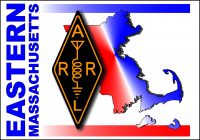
Notes from New England Division Cabinet Meeting – January 11, 2003 – Springfield MA
Tom Frenaye/K1KI + Mike Raisbeck/K1TWF
A. Introduction
1. List of attendees sent out in separate e-mail
2. Purpose of cabinet meeting – to gather information and advice in advance of the ARRL board meeting.
B. Membership and growth
1. Overall ham population is flat – 682,000 nationwide, 20,000 new hams last year, but net change was only +2220 hams nationally.
2. Change in New England was a loss of 15 overall, northern NE growing, southern NE losing hams
3. ARRL membership – trend down across the region – 274 loss overall in NE. Trend was downward in all NE sections.
4. ARRL membership 156,815 full (licensed) members. Another 10,00 are associated members, foreign members or have subscriptions.
C. Expected Board of Directors Issues Next Week
1. Discussion/action on getting new people licensed (and relicensed)
2. 2003 budget – recommended by Admin&Finance committee
a. typically, $3 or 4M available from 14 M budget after fixed recurring expenses covered (for advocacy, membership services, volunteer resources)
b. question – is it worth spending lots of money to defend all of our microwave allocations? Lots of pressure particularly for unlicensed devices.
3. Strategic planning
D. Spectrum planning
1. Low power device rules are sliding (causing us more interference)
2. FCC not particularly supportive here
3. If we make a big fuss over part 15, will the FCC just go to Congress to change the rules?
4. Spectrum protection act – got 53 house sponsors last year – will reintroduce this year – but only 1 from NE – did get 4 NE senators
5. To defend microwave space, we need to develop things to do that will attract more usage
6. Typically, a lot of spectrum protection work done by Chris Imlay, with technical backup by League staff
E. Getting Legislative Support
1. Takes a lot of banging on doors – a “game of inches”
2. Know your “two minute drill” (elevator speech)
3. Mary H. – we got a great reception in Washington from the Homeland Security folks.
4. Maine has been particularly successful in getting Congressional support
5. Amateur Radio Emergency Communications Consistency Act – HR4720 – to allow radio in CCR covered places – real estate lobby is very strong – got 35 sponsors
6. Phil T. – are there specific targeted mailing lists for interested amateurs (ie., SGL’s) in the legislative arena?
7. Would it be possible to “regionalize” QST ??
8. Big problem getting hams to “write their congressman”
F. Getting membership
1. Biggest challenge is getting people on the air and active
2. Bill W. – give League membership as a gift
3. To get from 160,000 to 200,000 members, we could buy memberships for $1.4M
G. Mary Hobart/K1MMH – development
1. Key to fundraising is in setting up relationships with people
2. In picking donors…
a. Does person have the interest?
b. Does he/she have the money?
3. Advocacy costs us about $1.2M per year – in defense of frequencies we’ve gone up from $200K through donations per year, up to $400k, but last year back down to $250K
4. We now have 40 schools participating in the Big Project – now looking for objective ways to measure success here
5. Currently testing a campaign to endow W1AW – $2M – 3M would be nice
6. History project now underway using seed money – need to measure possibilities here, too
7. Diamond club – funds not restricted – this makes it particularly important. – over 400 have signed up since program started in September
H. Dave Hoaglin/K1HR – Contest Advisory Committee – reported not a great deal of activity
I. Frank Murphy/N1DHW – brief report on Salvation Army/SATERN-Boston activity
1. Beginning to build up state-based groups
2. net on 14.265 M-F
J. Big Project Schools
1. Worcester East Middle School (MA)
2. Orono Middle School, ME
3. The best combination is school with ham-licensed teacher, and a supportive local club
K. Logbook of the World
1. In beta test now
2. Possibly public test in a month or two
3. Is it possible to flag Q’s in LOTW for special purposes (ie., info only, no credit)
L. Tower cases – very little happening in NE at the moment
M. Educating the public about ham radio – the future
1. More Archie comics, or some updated equivalent?
2. Morse code certificates have been popular
3. Problem is that the general public doesn’t know anything about us
4. Hams (unlike other hobbyists) don’t identify themselves publicly as ARRL, but rather as members of individual local clubs. Push branding down a few levels?
5. Maybe the term “amateur” is not serving us well.
6. Effort must be sustained
7. Look at example of AOPA
8. Strong support for more ARRL action on this and gaining new hams
N. Auction of publications gained $148 towards the ARRL Lab fund
O. WARC-03
1. 40 meters realignment still a mystery
2. Threat from earth sensing radar at 435 MHz
3. Elimination of CW as international requirement – quite probable
P. HF digital committee
1. Where should the broader HF digital modes go?
2. Possibly revisit digital control
3. Reconsideration of sub-bands
Q. VHF awards and contests – working on making these more appealing, to increase activity
R. Section reports
1. CT
a. participation in UTC grant
b. reactivation of packet network
c. some cabinet reshuffling
2. EMA
a. 100th Marconi operations
b. website updates
3. RI
a. Bob will run for another term
b. Doing well
4. VT
a. rebuilding ARRL presence
S. NEQP – good activity with 260 logs in 2002, next running is May 3-4, 2003
T. Miscellaneous comments
1. Kudos for Boxboro
2. Noted some interference in ARRL news bulletin recording
3. Put America back on ARRL materials
4. Echolink – FCC is investigating control issues
5. Plug for Eastern States expo
Thanks to K1TWF for taking notes! — Tom

